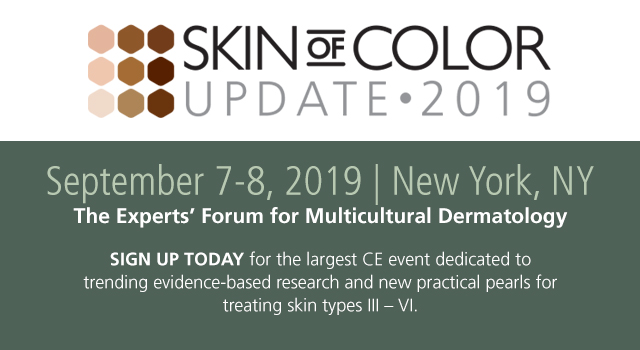This article features a recap of the Skin Lightening Panel at the 2018 Skin of Color Seminar Series, now known as the Skin of Color Update. Dr. Bridget Kaufman, onsite correspondent for the meeting, shares highlights directly from the experts, Drs. Eliot Battle, Seemal Desai and Valerie Callender.
Each panelist started with a PowerPoint presentation on skin lightening, followed by a panel discussion. Rather than reporting on the session chronologically, I have divided the session into key points. Under each key point, I have indicated each faculty member’s contributions and opinions on the topic. *Clinical pearls* from this session are bolded, underlined and marked with asterisks.
Key Point 1: Skin lightening is the result of deep-seated, long-lasting cultural ideals of beauty
Dr. Battle – “If you can’t be dark skinned in Africa, where can you be?”
For centuries, fair skin and blonde hair have been associated with beauty. This ideal of beauty stems from caste systems and racial superiority beliefs throughout the world. During the colonization of Africa, those with white skin (Europeans) were thought to be racially superior. In India, the Hindu caste system is based on skin color. Further, those who work outside (i.e. slaves in America, poor people) develop a darker complexion than those who stay indoors (i.e. rich people, offspring of slave masters who worked in the house) – therefore, *social standing directly correlates with skin color in many cultures*. The centuries-old belief that light skin is beautiful has been continuously perpetuated by the media.
Dr. Desai – As alluded to by Dr. Battle, skin color is associated with social status in Indian cultures. Lighter skin is an indicator of higher social status and is believed to be beautiful. The color of your skin has implications on proposals, job opportunities, and how you are viewed by your community. Many people in Asia and Africa live in cultures where you are programmed to think that if you’re dark, you’re of lesser value in the community.
Key Point 2: Skin lightening is performed throughout the world with increasing frequency
Dr. Battle – Skin lightening is performed throughout the world, including Asia, Africa, Europe, and the United States. The largest and fastest-growing markets are in the Asia-Pacific region, where skin bleaching agents are ubiquitous in drug stores, supermarkets, beauty stores, etc. In Nigeria, 77% of women use skin lightening agents. In the United States, clinics are now offering full body skin lightening treatments. There are currently 6 glutathione clinics in Washington, D.C.!
Dr. Callender – Once people start lightening their skin, they cannot stop. Once, a patient came into her office saying that she cannot stop lightening her skin or her husband won’t recognize her. Similarly, “lighter” skinned women who have bleached their skin will give birth to darker babies, and the father may end up wondering what happened…
Dr. Desai – Dr. Desai was in Kuwait prior to SOCCS and found that, even in the Middle East where women are well veiled, women want lightening of their face and extremities. The Philippines and several other Asian countries have banned the use of IV glutathione completely. In Singapore, however, you can still walk down one of the main commercial streets, Orchard Road, and see spas advertising IV glutathione. IV glutathione is being offered in all of our major U.S. cities.
Key Point 3: Glutathione is an antioxidant that is administered intravenously in health spas to achieve full-body skin lightening
Dr. Battle – Glutathione is an antioxidant produced by our body that helps prevent damage to cells. When present in the skin, glutathione can interfere with the production of melanin pigment, resulting in lightening of the skin. *Typically glutathione is administered intravenously rather than orally because glutathione is quickly broken down in the GI tract.* No large, long-term studies on IV glutathione have been performed demonstrating its efficacy. Recent studies suggest that oral glutathione plus antioxidants has some skin lightening effects, but the majority of glutathione cannot be absorbed into the system through the gut.
Dr. Callender – Glutathione is not just used IV! Now there are glutathione soaps. There is an online celebrity that teaches people to bleach their skin using chemical peels and glutathione.
Key Point 4: No large, long-term studies evaluating the safety of glutathione have been performed; IV glutathione is not safe!
Dr. Battle – As indicated in this section’s heading, there are no large, long-term studies of IV glutathione to establish its efficacy or its safety. *Although many people will not experience any side effects, known adverse events include toxic effects on the liver, kidneys, thyroid, and nervous system, skin rashes, and death.*
Dr. Callender – The FDA has put out a statement about the risks of IV glutathione. We know that it’s not safe. We are very scared that *IV administration is being performed under un-sterile conditions* in health spas, which could lead to infection, emboli, etc.
Dr. Desai – *There is no scientific evidence to support the use of glutathione.* Glutathione solutions used in the US are being supplied from Asia where manufacturers are producing this drug in fairly unstable settings. There is risk of death, SJS, TEN, etc.
Key Point 5: Advise your patients not to use IV glutathione; instead, recommend photoprotection (sunscreen, polypodium leucotomos), non-hydroquinone cosmeceuticals, and in-office procedures (i.e. chemical peels) for patients interested in skin lightening.
Dr. Callender –We should teach our patients that there is a difference between skin lightening and skin bleaching. Skin lightening to treat isolated hyperpigmentation (UV-induced hyperpigmentation, melasma) is okay, but entire body lightening is not necessary. *Sunscreen protection is the most important treatment for “lightening” the skin. Studies have shown lightening of the skin of Hispanic and African American patients with sunscreen alone.* Non-hydroquinone cosmeceuticals also help lighten the skin in conjunction with sunscreen, but they take a long time to produce an effect. Hydroquinone is a good option for short-term treatment of hyperpigmentation. *Polypodium leucotomos is also very helpful for protecting the skin against hyperpigmentation.*
Dr. Desai – Our job is to educate our patients that we are their advocates and we want to treat them safely. Dr. Desai advises his patients not to go through with IV glutathione. However, occasionally patients will come in saying “I know what I can get and I will do it.” Dr. Desai has let patients take oral glutathione because he knows most of it doesn’t get into the bloodstream (it’s mostly degraded in the gut).
For patients with melasma who want full face lightening in addition to treating melasma, tranexamic acid is a useful medication (tranexamic is an oral fibrinolytic drug that is not FDA approved for this indication). Polypodium leucotomos and sunscreen are also key. In addition, *physicians should discuss topical cosmeceuticals and chemical peels with their patients. Often patients think that they are “lighter” once the skin becomes brighter and has better texture/tone.*
Key Point 6: Well-designed scientific research on glutathione is needed
Dr. Battle – Dr. Battle pointed out that we change people’s bodies all the time. He questioned whether it is right for physicians to tell patients that they won’t help them change their skin tone, but they will surgically change their breasts or hair, perform liposuction, etc. He then questioned whether we should perform studies on skin lightening agents. Since we cannot completely prevent our patients from using glutathione, should we start looking into safe ways of administering glutathione so we can at least offer safer protocols?
Dr. Callender – Safer routes of administration and safety studies are the way that we have to go.
Dr. Desai – We need more data. An Italian pharmaceutical company is performing phase III studies on sublingual glutathione, which is absorbed into the bloodstream and bypasses the GI tract. Perhaps this will be another alternative once the results become available.
Did you enjoy this post? Find more on Skin of Color here.


